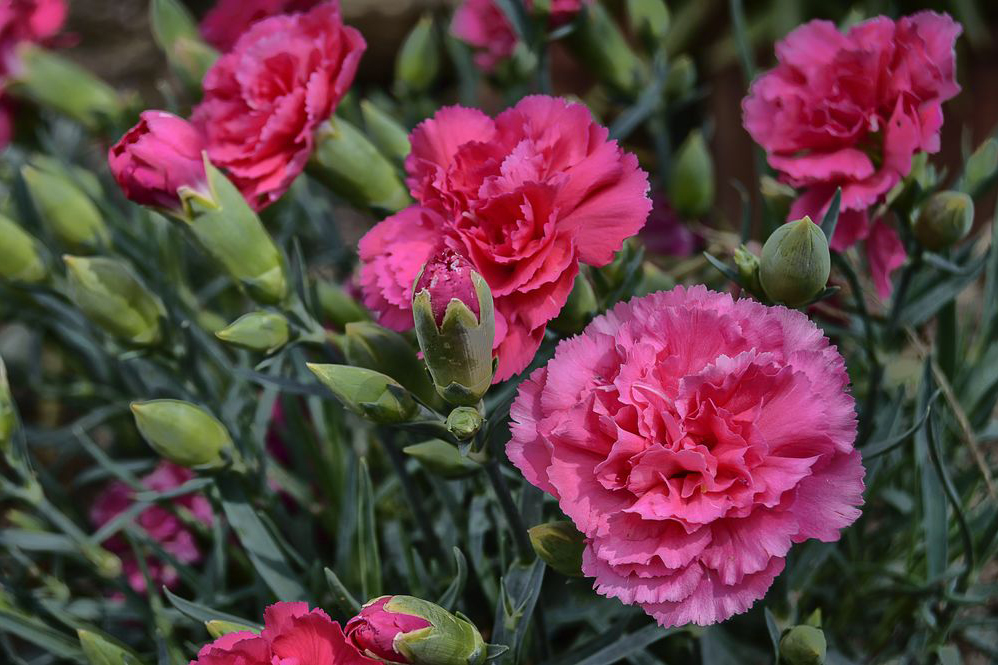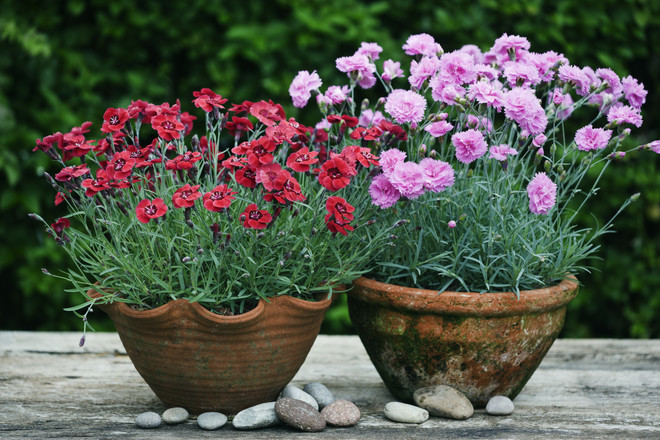Perennial carnation - planting in the garden and care
Content:
Perennial garden carnation is a very decorative plant, and at the same time unpretentious. It is perfect for decorating a flower garden or an alpine slide. Separately, it should be noted that this plant not only pleases with lush flowering, but also with a pleasant aroma.
Annual garden carnation
Annual carnations have a huge variety of species. There are ready-made mixtures on sale that allow you to grow a bush with a different shade of inflorescences. Growing this flower as an annual plant also gives you the opportunity to experiment with varieties. It is possible to grow an annual carnation not only in the open field, but also in flowerpots, which expands the options for its use in the design of the site.
To grow this plant as an annual crop, the seedling method is used. Sowing seeds is carried out in late February - early March. For growing seedlings, you should use a light and nutritious soil.
For the first 4-5 days, the container with seedlings should be in a dark room with a temperature of 18-20 degrees. After the entrances appear, it must be placed on a sunny windowsill. After a month, the seedlings should be opened and the tops should be pinched.
It is necessary to plant young plants in the ground not earlier than May. The threat of frost should have passed by this time, and the soil will already be warmed up enough.
Perennial carnation
This wonderful flower is quite easy to grow. To obtain a new copy, you can use several types of reproduction:
- seeds;
- cuttings;
- layering;
- dividing the bush.
The choice of method depends on the type of flower and the technology of its cultivation. Heat-loving varieties of carnation are usually grown as an annual or biennial plant. There are certain species, like the Dutch variety, that can only be fully grown in a greenhouse.
Perennial garden carnation - how best to propagate
The two most common breeding methods for this species are by seeds and cuttings. Both of these methods are widely used by gardeners.
Seed propagation is preferred for perennial carnations. This makes it possible to get a plant with a different shade of inflorescences and allows you to grow this crop in pots and flowerpots. In addition, it is not always possible to get cuttings of a plant of exactly the variety that you dreamed of. In this sense, the acquisition of seeds is a simpler task.
Perennial carnation seeds can be obtained by yourself. To do this, you should wait until the end of flowering and leave several faded inflorescences on the bush to ripen the seeds. When the seeds are ripe, they are carefully crushed into a small paper envelope and laid out in a thin layer to dry. Next, the prepared seeds are placed in an airtight package and stored in a dark and dry place.
Popular species and varieties
The number of species and varieties of perennial carnations is striking in diversity. There are compact and miniature species, and there are also taller ones, suitable for use in bouquets.
Carnation perennial undersized
One of the most unpretentious species. It is widely used in landscape design to decorate mixborders and alpine slides. Most varieties are unpretentious in care and are able to fully grow even on the poorest soils.
There are many popular undersized varieties. One of them is sandy. She is very unpretentious. Prefers sunny locations. The height of the shoots does not exceed 30 centimeters. Abundant flowering from July to late August.
Turkish carnation perennial
One of the most frost-resistant varieties. Suitable for growing in almost all regions of Russia.
The flowers are fragrant, collected in inflorescences, on one plant they can have a different shade. Great for arranging bouquets. The height of the shoots is about 70 centimeters. Flowering lasts from June to the end of July.
Chinese perennial carnation
It is a perennial plant, but in cold climates it is recommended to grow it as a two-year-old carnation.
Depending on the variety, flowers may vary in shade and size, some varieties have double inflorescences.
Flowering occurs in August. Some varieties are distinguished by longer flowering throughout the summer. The length of the shoots can be from 15 to 50 centimeters.
Perennial pinnate carnation
Differs in a rather large size of flowers - 2-3 centimeters in diameter. The height of the bush does not exceed 30 centimeters.
Blooms from early June to late August.
Alpine carnation perennial
One of the shortest and most compact species, one might say dwarf, the height of the shoots varies from 15 to 25 centimeters.
The flowers are pink or crimson.
Unpretentious and able to grow on poor rocky soils. Great for decorating alpine slides.
Perennial Shabo carnation
A distinctive feature of the variety is that the double flowers are collected in inflorescences. It also has a long flowering period - from July to the onset of cold weather.
The height of the shoots can reach 65 centimeters.
Perennial ground cover carnation
Ground cover plants are widely used in landscape design. Many of them are distinguished not only by their unpretentiousness, but also by abundant flowering. The most common type of ground cover carnation is the herb.
The herb has creeping shoots, which, during the flowering period, are covered with a large number of inflorescences. It is not demanding on the soil and is able to grow even on rocky ground. At the same time, it requires minimal watering and maintenance.
The main requirement for this plant is a sunny location.
Planting and care in the open field
Several methods can be used to propagate perennial carnations. It depends on the selected variety and the capabilities of the grower.
Seed propagation
One of the most common breeding methods for garden perennial carnations is growing seedlings from seeds. This method allows you to get a plant of the desired variety without much labor.
You can start sowing from the end of February. The process of growing seedlings can be divided into several stages:
- Soil preparation and containers
Sowing soil should be light and nutritious. To prepare it, you should mix garden soil with three parts of sand, two parts of compost and one part of peat. The container and the prepared soil must be disinfected.For this, either treatment with a solution of potassium permanganate or disinfection by calcining is used.
- Seed preparation
First of all, you need to decide on the variety. After the selection is made, the seeds should be soaked in a weak manganese solution for disinfection.
- Sowing
Clove seeds should not be buried in the ground. They are sown on the soil surface and sprinkled on top with a small amount of sand.
Next, the container is covered with film or glass and kept at a temperature of at least 18 degrees in a dark room. After the emergence of seedlings, the seedlings are moved to the lightest window sill.
A month later, when the plants grow up, they need to be opened and pinched off the top.
Propagation by cuttings
If possible, you can get a new copy of the plant of the desired variety by cuttings. This method allows you to speed up the breeding process and achieve flowering already in the year of planting.
They start harvesting cuttings in late May or early June. For this, a healthy shoot is used, which has 3-4 leaves. The lower leaves should be removed.
Next, the processed cuttings are buried in the prepared soil. It is better to choose a light, sandy soil. It should also be moistened before planting. If all the conditions were met, after 2-3 weeks a root system is formed and the seedlings start growing.
Dividing the bush
This method also applies to perennial carnations. But it cannot be used for all varieties of this plant. In some species, the root system has one core and it is not possible to divide such a bush.
To obtain a new plant in spring, the bush is completely dug up and divided into two or more parts. Then, obtained as a result of division, the plants can be transplanted into the ground to a permanent place.
Care of young plants
Young seedlings for full development should be provided with full care. Care should be taken to ensure that the soil does not dry out. At first, young plants constantly need moisture.
The tops of the plant should be pinched. This will strengthen the branching of the shoots and prevent the seedlings from stretching.
You should also pay attention to loosening the soil and weeding it from weeds.
Before the onset of cold weather, plantings should be covered. Young, not matured, plants may not tolerate severe frosts. Overwintering without shelter can lead to plant death.
Planting seedlings in the ground
You can start planting seedlings in the ground only after the threat of frost has passed and the soil is sufficiently warmed up. As a rule, this is mid - end of May. But for some regions, the dates may be later, given the peculiarities of the climate.
Before you start planting ready-made seedlings, you should decide on the landing site. This perennial prefers sunny places. The soil must be prepared depending on the exactingness of the selected variety. Some species prefer nutritious soil, and for some varieties, poor rocky soils are enough.
Carnation care in flower beds
Despite the unpretentiousness of this plant, it still needs some care.
One of the important points is watering. For cloves, it should be moderate.
Also, for abundant and prolonged flowering, fertilizing with mineral fertilizers should be regularly carried out. It is better not to use organic fertilizing, only the use of compost in limited quantities is permissible.
Some species, such as perennial bush carnations, require support and a garter.The fragile shoots can break under the weight of the inflorescences, so they should be carefully tied to a support. It is better not to tighten the fastening tightly so as not to damage the stems.
Diseases and pests
Perennial garden carnation is highly resistant to pests and diseases. Plants usually do not get sick with proper care.
Garden carnation is a spectacular and unpretentious plant. With minimal care, she pleases with lush flowering every year.
The variety of varieties allows you to choose the variety that best suits your style and preferences. Some people prefer perennial terry cloves, while others prefer an annual variety.
Reproduction of this plant also does not require special skills. It can be done by growing seedlings from seeds, by cuttings or dividing the bush. Depending on the characteristics of the variety, you can choose one or another method.
Carnation can be cultivated as a perennial or annual plant. Depending on this, a breeding method should be chosen and the peculiarities of agricultural technology should be taken into account. Everyone, even a beginner, a florist can grow this wonderful flower on a personal plot.


























